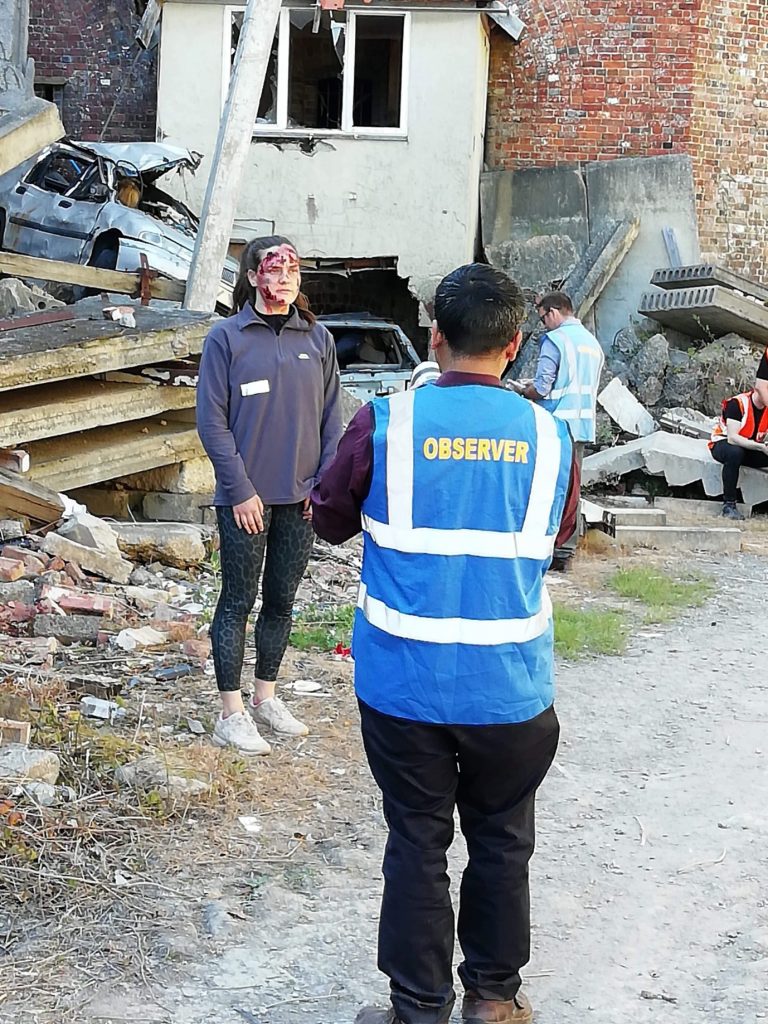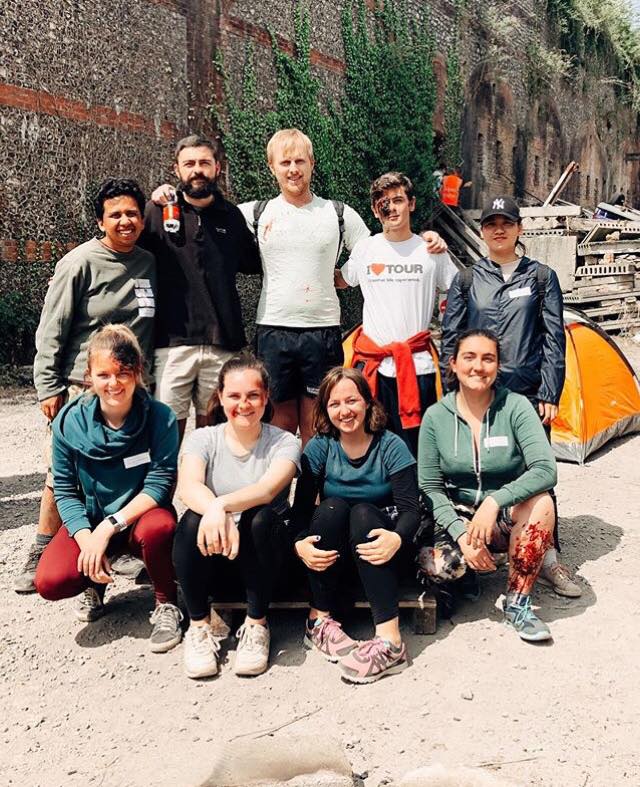Seeing theory in practice: HCRI students participate in SIMEX, the UK’s largest annual international disaster response exercise
Blog edited by: Dr Billy Tusker Haworth and Dr Stephanie Rinaldi.
Contributors: Rachel Cass (RC), Anna Fraine (AF), Hanqi Liao (HL), Morgan Payne (MP), and Eliza Van Overschelde (EVO).
Every year organisers from several UK agencies conduct the SIMEX Series disaster response exercise. It is a three-day operational exercise in which multiple ‘players’ from response agencies test, develop, and practise their disaster response plans and procedures. Organisers create a fictional disaster scenario, the effects of which are simulated across multiple sites near Portsmouth. Hundreds of role players take part to represent the affected population and this year HCRI took a group of students to get stuck-in and find out more…
Having just completed all of our second semester assignments, ten of us travelled down to sunny Portsmouth for the 3-day simulation event. Joined by a diverse number of organisations and groups, we were briefed on our roles and sent into the exercise over a number of different locations. The international exercise was based on a disaster that had arisen after a tropical cyclone devastated the fictional country of ‘Mass’. (AF)
Having the opportunity to be involved in SIMEX 2019 allowed me to observe in action the theory and knowledge I have gained this year with HCRI. We were based at Fort Purbrook (role player management centre) and Fort Widley (simulation centre). I played the role of: a desperate and hungry IDP [internally displaced person], a burn victim, an IDP with a severe arm crush wound who became unconscious, a disorientated and anxious 17 year old who lost her family late at night, and a refugee who needed rescuing from an enclosed location at risk of a dam breaking. (RC)
On the first day I was a victim of a storm, lost in the woods awaiting rescue. On the second day I was an IDP attempting to interact with responders. Finally, I was hospitalised twice with major thoracic (chest) injuries in the UK-Med field hospital. (MP)
Being on the ground and involved in the scenarios, it allowed me to observe the processes involved with tackling a disaster throughout the disaster management cycle; response, recovery, preparedness, and mitigation. The simulation focused on the response and recovery aspects, with multiple organisations working alongside each other. (RC)
The simulation highlighted the complexity of the response phase in the Disaster Management Cycle. Although traditionally one stage, in reality it was at least three distinct stages: displacement, rescue (response), and recovery (hospitalisation). This highlighted the complexity of this stage of the disaster cycle – opposed to simply being the stage in which responders save lives. Secondly, it exemplified how utilising volunteers can work in disaster response. The Hampshire Fire and Rescue service used SIMEX as a chance to familiarise their volunteers with Search and Rescue. When I was eventually rescued on the first day, I saw how newer volunteers were partnered with those more experienced. It was encouraging to see the overall effectiveness of the teams despite their various backgrounds. (MP)
There were also multiple times where we got moulage done and then were sent to the UK-Med tents to get triaged and helped. The first time I just had facial bruising and was released quite quickly after getting admitted. The second time I was a pregnant woman who had tripped into a ditch after an earthquake. The different ingredients the makeup artists used for different things was also quite interesting to watch (to keep me looking sweaty they put lubricant on my face). While in the UK-Med tents, I witnessed how I and the patients around me were triaged, and the steps the doctors took to help us. I also saw how being in a temporary medical camp can limit the options for helping someone. When I was the pregnant woman, they wanted to transfer me to another hospital, one that was better equipped to take care of me, but there would be issues with the transfer, so I was sent home. Providing medical care is never as straight forward as it is at home when you are in a disaster zone. (EVO)
Whilst on the ground as a role player it became apparent to me just how important communication with officials was. This is something that can be easily taken for granted by those on both sides of the disaster. The head of security came over at one point on day 3 and he had a hand gun in his belt and he stood in a very dominant manor with his arms closed, which was both offensive and overpowering. I therefore learnt that the way you communicate is not only through the spoken word but through body language as well. (RC)
SIMEX offered me a fresh perspective on managing disasters. It helped me imagine being a victim of a disaster. The experience was completely different to researching theories and case studies. Lying down in a hospital bed unable to move, I felt helpless. Despite being able to understand people around me, and not actually being hurt, I still felt completely disorientated as I was unsure who or what I was waiting for. I was able to better appreciate how victims of a real disaster might feel. Being in excruciating pain whilst surrounded by foreign medical staff speaking words you do not understand would definitely be traumatic. The experience helped me appreciate saving people is not simply saving their lives, but trying to minimise the impact of the disaster upon them. (MP)
The second day of the simulation jumped forward to six days after the cyclone. I played an IDP who was becoming increasingly frustrated about the prioritisation being made by humanitarian agencies to assist refugees over IDPs, who fall under the responsibility of their government. This, too, happens in reality during crises and responses. Since the UN still does not have a specialised agency that operates specifically for IDPs, the responders in the exercise were faced with the challenge of how to engage with populations in need whose voices have been marginalised and neglected. (AF)
On the final day, we were able to partake in a workshop run by SPHERE, the humanitarian organisation based in Geneva who developed the ‘Humanitarian Charter and Minimum Standards in Humanitarian Response’. The workshop involved discussing inclusion standards for older people and people with disabilities. Throughout the masters I have been studying this year (MA Humanitarianism and Conflict Response), the importance of collecting disaggregated data, knowing and responding to needs on the ground and prioritising those who require the most assistance, has been repeatedly emphasised. In this workshop I learned more about how assessments are made, using what is known as the ‘Washington Group Questions’, to ensure that people with disabilities, and their needs, are accounted for. We also made our own assessment, using the HHoT (Humanitarian Hands-on Tool) app, to assess how many of the SPHERE guidelines, for accessible latrines, were being met in the location where we were based, in Fort Purbrook. The app includes guidelines for everything that would be needed to set up an emergency refugee/IDP camp, including shelter, security, and food and water points that can be accessible to people with disabilities. (AF)
Indeed, from this SIMEX exercise, it is quite useful for me to know the real feeling of the affected population when a disaster happened. And from this aspect, the experiences of role players as affected people in SIMEX are valuable to the staff of humanitarian organisations and the citizens. For humanitarian organisations’ staffs, also for the students from HCRI, I think it is a good opportunity for them to understand the situation and the feeling of the affected population. So, they can better to know the actual needs of the affected people and combine theory with practice. (HL)
SIMEX was a great experience for me as an International Disaster Management master’s student. It was not only eye-opening in terms of disaster response, but a bonding experience due to all the time my peers and I spent camping, chanting through medical camps, and eating the same burgers twice a day for three days. (EVO)
This experience has opened my eyes to what is required going forward to strengthen the humanitarian industry so that it can respond effectively to future disasters. (AF)
Students who took part in this experience were enrolled on our BA in International Disaster Management & Humanitarian Response, MSc International Disaster Management, or MA Humanitarian and Conflict Response courses.





0 Comments